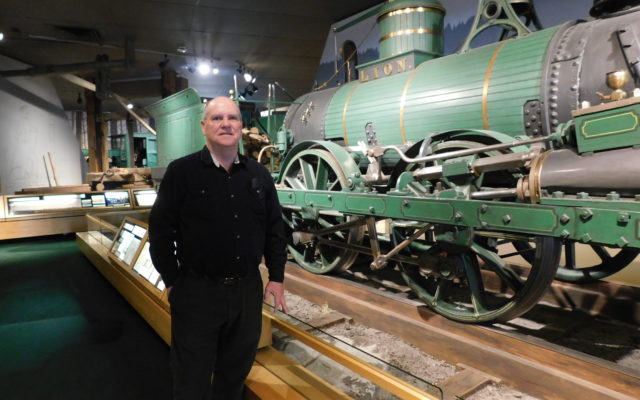
Retired Air Force officer pens book on how railroads powered the growth of Maine
By Paula Brewer, Star Herald Staff
PRESQUE ISLE — When retired U.S. Air Force Maj. Bill Kenny was 11, he boarded a passenger train in Old Town, bound for a lifelong fascination with how railroads became the economic workhorses that built Maine.
“My father pinned my name and my grandparents’ phone number on my shirt and put me on a train in Old Town to go to Union Station in Portland for my grandparents to collect me,” he said. “It was quite a thrill for an 11-year-old. I’ve been hooked ever since.”
The Old Town native was deputy chief of logistics plans for the 42nd Bombardment Wing at Loring Air Force Base from 1983 to 1985. He also managed railroads at Eielson AFB in Alaska and in South Korea, directing movement of equipment and munitions for Operations Desert Storm and Desert Shield in 1990-91.

MAINE RAILROAD HISTORY — Bill Kenny, retired U.S. Air Force major, stands next to the Lion, a historic steam locomotive at the Maine State Museum in Augusta. Kenny published his first book, “The History of Maine Railroads,” in June.
A former professor of international economics, organizational leadership and public affairs, he still consults on logistics for the paper and nuclear industries.
Kenny, 72, published his first book, “A History of Maine Railroads,” in June. In it he recounts how small railroads furthered industry and grew into larger systems, the key personalities involved and how the 20th century’s multiple transportation options impacted the once-great train lines.
But Kenny doesn’t see railroads as a thing of the past. He maintains they are poised for a resurgence, thanks in part to a Canadian buyout just this year.
“The book is truly about how railroads were and are now becoming again the economic engines of Maine,” he said.
In 1832 William Vance — for whom Vanceboro is named — built Maine’s first railroad in Baring, powered by horses, to transport lumber from his Calais mills. Businesses built their own private rail lines until Gov. Joshua Chamberlain, who served from 1866 to 1870, brought about public funding.
When passenger rail began in 1871, the occasion drew a visit from President Ulysses H. Grant.
“The Bangor and Piscataquis Railway and Canal Company was one of the [predecessors] of the BAR and the first passenger railroad in Maine. Even President Grant came to Bangor to ‘cut the ribbons’ opening this railroad,” Kenny said.
One of his favorite railroad stories is about a Portland man who was tenacious enough to snatch Montreal rail business from Massachusetts. The St. Lawrence River would freeze in winter, leaving Montreal businesses without a way to reach U.S. markets.
“John Poor of Portland beat Boston people to Montreal in 1885, traveling by sleigh through blizzards, and convinced them to come to Portland instead. That’s how the St. Lawrence and Atlantic Railroad Company was born,” Kenny said.
The Bangor and Aroostook Railroad began in 1891 to serve lumber mills in Millinocket and East Millinocket. In 1892, the BAR acquired the Bangor & Piscataquis Railway and the Katahdin Iron Works Railway, bringing rail into Aroostook.
Before the railroads, most mail to The County came through New Brunswick, Kenny said.
The Aroostook Valley Railroad, chartered in 1902, connected with the BAR and proved vital to the Presque Isle Air Force Base during World War II.
“AVR built a 2.5-mile connection from the base to be able to move munitions and military equipment,” Kenny said. “More than 435,573 tons of ammunition and high explosives moved via the BAR to the port of Searsport during World War II.”
As over-the-road transportation improved, trains diminished and tracks fell into disrepair. During the Gulf War, when Kenny had the job of sending tanks and munitions overseas, he discovered poor upkeep meant finding other ways to ship because poorly kept tracks couldn’t accommodate the weight.
He credited former Gov. John Baldacci, a longtime friend who actually wrote the book’s foreword, with helping to save hundreds of miles of Maine railroad.
In 2001, then-U.S. Rep. Baldacci joined a House subcommittee on railroads, pledging to revive the BAR — an effort he continued as governor from 2003 to 2011.
“The tracks in Aroostook County were almost torn up, but were saved by Gov. John Baldacci, working with Sen. Olympia Snowe and President Barack Obama, to get funding for the state to buy the tracks about to be abandoned,” he said.
“Their efforts are the reason shipping from Aroostook County is having a resurgence now.”
Railroads received a further boost in June of this year, when the Canadian Pacific rail line purchased more than 400 miles of track owned by the Central Maine and Quebec. The sale meant Maine would once again have a Class I railroad and better connectivity with a single rail company.
“If you’re a farmer in Easton and ship potatoes to Presque Isle, it now goes on one railroad line. If you can put it on one railroad and go all the way, it’s lower cost and can make it more profitable for farmers to expand,” Kenny said.
In fact, just last month, Presque Isle was the first leg of the journey for a number of tanks from the former Maine Military Authority in Limestone as they made their way to California by rail.
Kenny lives in Cumberland with his wife, Kathy, a retired librarian he jokingly referred to as his built-in editor.
The couple have a son, Tim, who lives in Texas with his wife Kim and daughter Madelyn.
With one book on the shelf, Kenny doesn’t expect to stay idle. He and Kathy are already on to their next adventure: a book on the history of Maine taverns.
The Bangor Public Library will host Kenny in a virtual author talk at 6 p.m. on Thursday, Nov. 5. Kenny’s official website is historymaine.com.